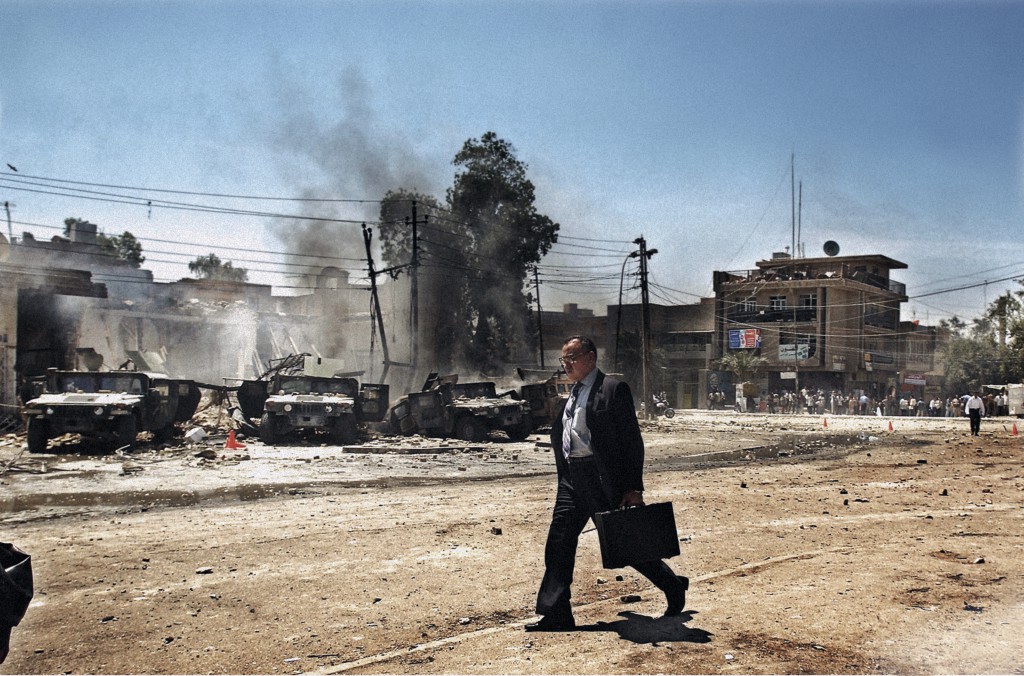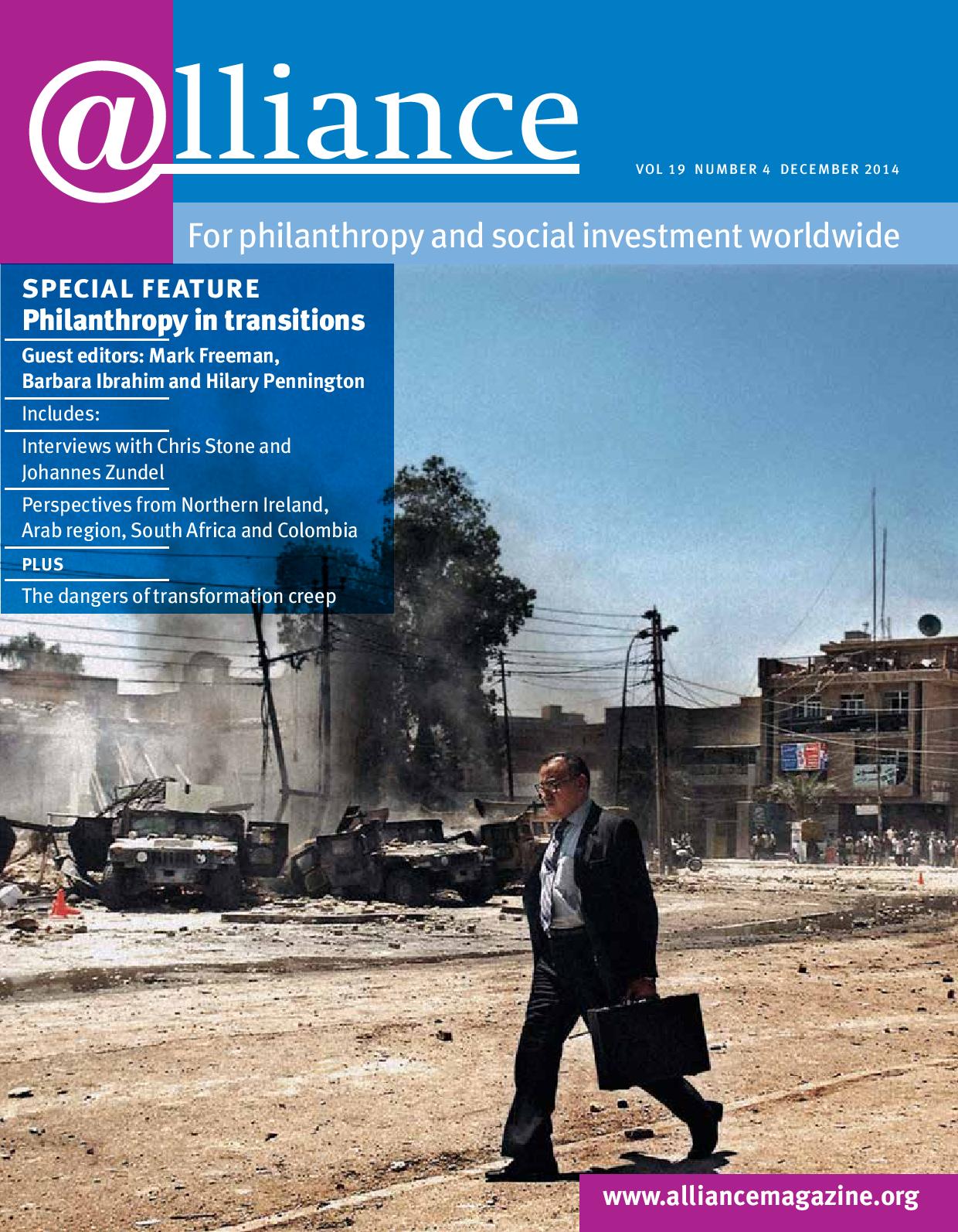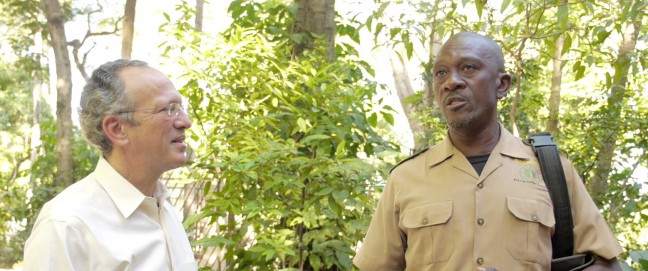Following the January 2011 revolt in Tunisia against the regime of President Ben Ali, the country’s transition leaders adopted an open-door approach to foreign aid. An avalanche of mostly uncoordinated aid followed. Donors – private and bilateral – arrived asking questions like, ‘Who is your Mandela?’ They produced an event overload, sponsoring dozens of conferences and hotel-room trainings on identical topics. Funding opportunities and partnerships were concentrated in the capital, Tunis, and in few other parts of the country. Grant applications were often English-only. Talent was drained from local organizations to produce repetitive mappings of civil society for external donors who rarely shared them.
Within a short time, the exhilaration over international support became a source of confusion and then frustration for many Tunisians.
Regrettably, stories like this have repeated themselves all too often in the early years of transitions out of armed conflict or authoritarian rule – despite the fact that private philanthropy has engaged in transitions around the world for over 40 years. Only recently has the sector become serious about a collaborative process of self-reflection and sharing of the lessons learned.
In late 2014, most agree that the harvest after four years of Arab transitions has been disappointing. Conflict, sectarianism and economic struggle have replaced the collective euphoria of early months when opportunities for positive change seemed unlimited. Cross-border philanthropy cannot be blamed for all of these setbacks. Yet, as the world reflects on mistakes made on many sides, there are success stories that also deserve closer attention. In every transition private donors emerge who do things smartly – coordinate more, adapt better, venture further, stay longer. These philanthropists prove that there is nothing inevitable about failure in the rebuilding phase after civil conflict or repression.

Baghdad, April 2004. An Iraqi man walks by the scene of an attack on US Army Humvees that caused several American casualties in the Al-Waziriyah neighbourhood of Baghdad. Photo by Moises Saman/MAGNUM
Genesis of this special feature
In November 2013, the Institute for Integrated Transitions and the Gerhart Center at American University in Cairo published Supporting Countries in Transition: A framework guide to foundation engagement. In a series of roundtable discussions with international foundation leaders to prepare the guide, some consensus was reached on guidelines for effective grantmaking and other forms of social investing in transition environments. Inevitably, though, some issues remained unresolved. How should we define and measure ‘success’ when it comes to transitions? What is the optimal mix of international versus local donor support? How can the new philanthropic landscape be better leveraged to support emerging actors on the frontlines of change when their societies enter promising but risky periods of transition?
To explore these and other questions, Alliance magazine invited the authors to organize this special feature. As guest editors along with the Ford Foundation’s Hilary Pennington, we were privileged to be able to commission articles, conduct interviews and engage with some of the leading voices in the field. All of these contributors believe that private philanthropy has a crucial role to play in successful transitions. At the same time, they point to important ways in which philanthropy could do better.
Several articles focus on the Arab region and its troubled transitions. They review why the experiences from other regions have provided limited guidance and reflect on the fragility of civil society groups after 40 years of repression. Finding and investing in young talent is a recurring theme, as is the need for raised appetites for risk. And the report on a summer 2014 expert roundtable convened in New York confirms the importance of using the opportunity of transition to foster inclusive political dialogue and nation-building.
Other interviews take a close look at the journey the Open Society Foundations and the Berghof Foundation have taken in their work with particularly difficult transition settings. A couple of the pieces in this issue also point to ways that transitions are changing in the 21st century – subject to closer media scrutiny, more threatened by identity politics and the closing of public space, but also benefiting from a younger generation that utilizes technology and networks to build creative social change movements. Key lessons from the experiences of past and present transitions in places like South Africa, Sierra Leone, Northern Ireland and Colombia are examined, as are new ideas and practices that can help inspire donors to bring their best to these turning points of history.
The transition mindset
If you are in philanthropy because you want to change systems and not just practices – and because you want to confront the causes and not merely the symptoms of violence and exclusion – transitions are for you.
Transitions represent those rare moments when the rules of the game are open to reform; when citizens take up the challenge of building a new social contract rather than struggling against a broken one. They are periods in history when change happens swiftly and dramatically. They are, in short, invitations to action for systems-minded philanthropists.
Transitions represent those rare moments when the rules of the game are open to reform; when citizens take up the challenge of building a new social contract rather than struggling against a broken one. They are periods in history when change happens swiftly and dramatically. They are, in short, invitations to action for systems-minded philanthropists.
Yet, looking at the map of the world today, one sees many examples of transitions gone wrong. Places where hopes rose when society took to the streets to demand dignity, only to see revolutions hijacked by violent spoiler groups or political infighting. Places where carefully managed national dialogues culminated in renewed conflict rather than peaceful consensus. Places where, decades after a successful break with authoritarianism or mass violence, crude one-party rule has re-emerged. Places where peace dividends never reached those on the margins of the economy and broader society.
At the same time, the risks of failure present in transitions are merely the flipside of the disproportionate opportunities they create for economic, social and political progress. In transitions, risk and reward go hand in hand. As Avila Kilmurray of the Global Fund for Community Foundations writes, ‘Independent philanthropy has been most important when it funded risk-taking initiatives.’
The ABCs of transitions
In a way, we all have clear intuitions and opinions about transitions. There is a vernacular we tend to use. For example, we generally associate ‘success’ with the transitions that took place in countries such as Spain, Northern Ireland, Chile, Brazil, the Czech Republic, South Africa, Ghana, South Korea and Indonesia. Likewise, we tend to associate ‘failure’ with countries such as Somalia, the Democratic Republic of the Congo, Iraq and Afghanistan. Even today’s ‘failing’ transitions tend to elicit quick consensus: Egypt, Libya and Yemen, among others.
However, the authors’ view is that labels like this do not hold up well under scrutiny. In every instance of transition, some system change has occurred, and some has failed to occur. A transition is anything but black and white.
The more typical examples of transition are the ones that do not lend themselves to easy characterization – El Salvador, Hungary, Serbia, Uganda, Liberia, the Philippines, Lebanon and Algeria – places where there is a very mixed balance sheet of progress and retreats.
Getting to why
The reasons that some countries do better than others in transitions are varied. One reason centres on starting conditions. All else being equal, a country that enters a transition with a solid middle class is likely to do better in transition than one without (eg Uruguay versus Kosovo); one that has functioning public institutions is likely to do better than one without (eg South Korea versus Tajikistan); one that doesn’t have deep sectarian divisions is likely to do better than one with them (eg Poland versus Nigeria).
Geography and neighbourhoods matter, too. Some countries have better luck than others in terms of the risk of violent spillover caused by problems in countries with which they share borders or other historical ties.
Moreover, there is broad consensus that today’s transitions are embedded in a more volatile global context marked by rising economic disparities, democratic deficits and disruptive technologies which, combined, challenge the tasks of nation states.
Yet, these hard-to-control factors should not eclipse another basic fact. The decisions taken during a transition by political, civic and business leaders – as well as the process for reaching those decisions – are just as important determinants of the direction a transition can take. It is precisely in this arena that philanthropy can play a crucial role in influencing outcomes for the better.
Rules to live by
Transition-focused philanthropy will look different from one place to another: the last kind of philanthropy worth defending in these contexts is one that comes from a pre-set template. At the same time, there are some basic rules of engagement that – if followed with intelligent adaptation – can help increase the chance of positive impact in any country emerging from war or oppressive rule.
Transition‑focused philanthropy will look different from one place to another. At the same time, there are some basic rules of engagement that – if followed with intelligent adaptation – can help increase the chance of positive impact in any country emerging from war or oppressive rule.
Be there early
There are reasons to be apprehensive about involvement in the unpredictable, and sometimes violent, transition taking place in a country one cares about. It can be tempting to say: ‘Let’s wait this out and see how the transition unfolds before we engage our funds.’ The lesson from decades of philanthropic engagement in transitions, however, is that while it’s important to think long term, it is the early interventions that have the greatest possibility of setting a positive course. Local decisions taken in the first months and years of a transition frequently establish the rules, structures and systems that facilitate or constrain political, economic and social advances for years to come. Thus, a small grant to civic leaders to promote their vision for an inclusive constitutional drafting process can leverage national impact that would not have been possible a few months later. As Ariadne’s Jo Andrews puts it: ‘Timing is everything: the right sum of money (often quite small) given at the right time to the right people is the most powerful social accelerant available on this planet.’
Be adaptive
Transitions are, by definition, periods of change. As the old saying goes: ‘When the music changes, so does the dance.’ Smart philanthropy in transitions adjusts by, for example, making grantmaking terms more open to informal and emergent citizen groups, seeking out new partners, measuring impact with more flexibility, and welcoming failure as an opportunity to learn and do better next time. A transition demands a spirit of trial and error – but one that is based on realism about the fluidity of change, not wishful thinking about guaranteed progress. ‘No matter how exhilarating and inspiring an initial transition moment is, and how wide the apparent consensus for change, outside actors should assume that the transition is precarious,’ warns Thomas Carothers of the Carnegie Endowment for International Peace.
Be politically attuned
The work of civil society matters before, during and after a transition. However, when change is the agenda, politics matter as much – or more. If the maximal goal is to support a transformation in power relations, then the minimal obligation must be to get closer to the edge of what is political – without touching the rail. Supporting arts and culture groups that subsequently gave voice to aspirations for political inclusion, for example, had a catalytic effect on Egypt’s 25 January revolution.
Yet even if one sets a much lower overarching goal – for example, seeking merely to ‘do no harm’ – one’s minimal obligation is to understand the politics of the transition. For all fields of grantmaking to succeed – from education reform to healthcare to youth unemployment – an awareness of the political situation and its shifting dynamics is essential. ‘Foundations would considerably increase the impact of their actions if they acknowledge that every aspect of life is coloured by politics,’ writes Arab Reform Initiative founder Bassma Kodmani, ‘and that democratic forces need financial and organizational support if they are to structure serious parties, build constituencies and articulate their agendas.’
Be brave
In a transition, two dynamics are taking place at once: the deconstruction of an old order and the construction of a new one – with all the tensions that such a process naturally implies. The easy path for a grantmaker is to fund conferences, trainings and the like, at which attendance is dominated by people who already agree with each other. That kind of effort has its place. Yet, those who are in it to help achieve systems change need to be willing to take on some of the heavier lifting, which involves building or supporting neutral spaces where ideological opponents can engage in dialogue. In Northern Ireland, supporting the self-organization of the survivors of violence and of recently released political ex-prisoners, both extremely sensitive issues, was risky but critical to the underpinning of the peace process. When such processes succeed, they can create the foundation stone for a transition to advance and deepen; but when they are avoided as being ‘too hard’ or ‘too sensitive’, the precondition for realizing all other ambitions is more likely to be absent.

Iraq, May 2008. A woman recovers at the Imam Hussein Hospital in the Sadr City district of Baghdad after suffering shrapnel wounds in a rocket attack fired from US forces into a residential building, during clashes between the Mahdi Army and American forces. Photo by Moises Saman/MAGNUM
Be organized
While some donors prefer the safety of the sidelines, others rush into transitions with inadequate information and understanding about the changing local structures they want to engage with. Donor networks have a crucial role to play here. By convening novices and experts alike, and pooling knowledge and contacts, they can help convince boards or reluctant officers that an unfamiliar but alluring country situation is indeed compatible with a foundation’s mission and comparative advantages. Networks can likewise help identify hidden opportunities and joint funding strategies for smaller donors that could enable them to have a bigger impact. The exercise takes time and can appear to slow down decisions and actions. But in reality it speeds up knowledge acquisition and enables everyone to make quicker – and better – choices.
Be multidisciplinary
If transitions are about forging new social contracts among social groups and between citizens and the state, the parameters of engagement need to be broader, not smaller. Donors that typically support established fields through fixed programme categories will find that transitions intensify the connections among all parts of the political and social order and therefore require a far more multidisciplinary lens. Systems change requires a systems perspective: the specialized boxes of grantmaking, which may work perfectly well in more predictable political environments that are conducive to log frames and results matrices, can be an enemy of transformation in contexts of transition. ‘We must be willing to look beyond the usual suspects for those who are connecting the multiple, segregated parts of the system,’ writes Ellen Friedman of the Compton Foundation.
Be different
Smart transition philanthropy doesn’t look the same as a lot of other philanthropy. It is not based on grand strategies set in boardrooms; it is bottom-up and responsive to new facts and fluid changes on the ground. It asks how standard donor procedures need to be modified rather than relied upon as though they were custom-built to suit any situation. Adjusting to the difference of transition contexts also implies allowing for greater flexibility in relations with partners and reaching beyond the usual suspects to support informal, untested actors and projects that appear promising but are anything except ‘sure bets’.

Afghanistan, March 2005. A boy covers his eyes during a sandstorm in the southern city of Kandahar. Photo by Moises Saman/MAGNUM
The case is clear
This special issue of Alliance presents a diverse compilation of ideas and experiences about what it means to ‘get philanthropy right’ in transitions out of armed conflict and authoritarian rule. There are no standard answers – and it would be dishonest to suggest otherwise.
Yet, there is one abiding theme in all of this. It has to do with the huge philanthropic opportunity that transitions can offer for changing the rules – precisely in the places where a disruption and reorientation of past dynamics and rules is most needed.
Naturally, the resolution of social, economic and political problems involves a long haul. That is why strengthening local partners and local philanthropy is an especially good bet. Yet a national transition will also offer possibilities for tackling other pivotal problems in a shorter period of time – while helping to put in place the essential building blocks for sustaining improvements well into the future. We hope this issue of Alliance contributes to that.
Even for philanthropists whose work stays closer to home, the experiences reflected in these pages should spark fresh thinking. Far from an isolated occurrence, transitions seem set to become the ‘new normal’ – and, as a sector, we need to be ready for that. As Berghof Foundation chair Johannes Zundel remarks, ‘For philanthropists prepared to take bold risks, transitions offer the chance to be at your best.’
The guest editors for this Alliance special feature are:
Mark Freeman, executive director of the Institute for Integrated Transitions. Email mfreeman@ifit-transitions.org
Barbara Ibrahim, director of the John D Gerhart Center for Philanthropy and Civic Engagement, American University in Cairo. Email bibrahim@aucegypt.edu
Hilary Pennington, vice president of the Ford Foundation’s Education, Creativity and Free Expression program. Email H.Pennington@fordfoundation.org
Moises Saman, Magnum photographer
Moises Saman is the contributing photographer for this special feature. He is a Magnum photographer based in Barcelona, Spain. He has been covering news and longer-form narrative stories for over 17 years, across the Middle East, Latin America, Europe and other parts of the world. Moises worked for seven years as a staff photographer at Newsday (2000–07), covering the wars in Iraq and Afghanistan, and has been a regular contributor to the New York Times, Human Rights Watch, Newsweek, TIME magazine and other international publications and NGOs. In 2010, Moises moved to Cairo to start covering the Arab Spring.
Moises is currently working on a new project, titled DISCORDIA, which tells the story of his personal journey through the Arab Spring. DISCORDIA covers four years of Moises’ work in Egypt, Syria, Libya, Tunisia, Lebanon and Iraq. Through a series of intimate photographs, it chronicles these countries’ attempts to make the transition out of dictatorship, capturing the exhilaration, anger and despondency generated by the Arab Spring’s triumphs and failures. Moises recently received the prestigious W Eugene Smith Memorial Fund Fellowship for his work on DISCORDIA, and he hopes to publish the project in book form next year. Over the years, Moises’ work has also received awards from the World Press Photo, Pictures of the Year International and the Overseas Press Club, and his photographs have been shown in several exhibitions worldwide.








Comments (0)